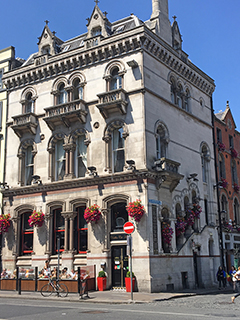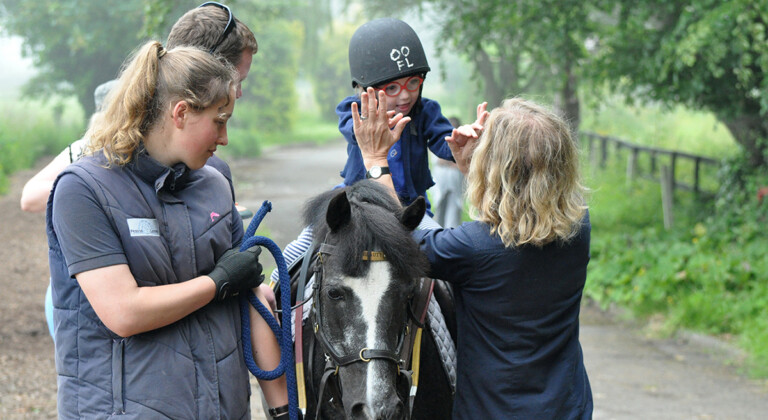Rider and coach Cathy Binz has long had an interest in equine therapeutic modalities, and in particular the effect of horses and horse-riding on children with Autism Spectrum Disorder, (ASD). She was recently invited to attend the HETI (Horses in Education and Therapy International) conference in Dublin and wrote this special report for HorseVibes.
I had never thought of visiting Ireland, probably because I’m pretty sure I must be the only person in the world not to have a drop of Irish blood in me, but the opportunity to present my investigations into horse riding therapies and children with Autism Spectrum Disorder, (ASD) to an International audience with attendees from all around the globe was too good an opportunity to miss.

The Conference showcased all the work and dedication from people all over the world who share in a magical vocation; one that includes facilitating small, yet mighty triumphs from individuals who have often been given giant crosses to bear with their physical and/or mental health. It is such a privilege to do what we do and I wouldn’t swap my job for the world.
We landed in Dublin on a stunning summer morning, breaking through the clouds to reveal a patchwork of green, green fields and hedges surrounding the city. Of course, I know that green fields speak of a climate that offers a large amount of constant rain, but for my entire trip the weather did not vary from sparklingly sunny and warm. Irish eyes were indeed smiling!
But back to the main purpose of my trip – the HETI Conference. The Welcome Ceremony involved, what else? Horses. Ireland has a long tradition of horses in numerous disciplines and proudly featured a parade of their finest equines, including two huge national-level showjumpers, Irish draught horses, beautiful Connemara ponies, Irish cobs, donkeys and a brand new (but extremely old) breed that was only identified in 2010 by DNA testing – the Kerry Bog Pony. (Not the prettiest name in the world for such lovely ponies.)
I had been fortunate enough to be accepted for two presentations at the conference; my talk, and a poster presentation. My poster theme was Humans Helping Horses Helping Humans and was based on a project that I’d been involved with earlier in the year.
The intent behind my presentation was to show the logic of involving rescue horses with equine therapy programs. A lot of rescue horses, particularly older ones are very unlikely adoption prospects – people mostly prefer younger, rideable horses. However, these older horses can be ideal participants in therapy programs, often having quieter temperaments and a lifetime’s worth of training to offer. The logic of combining the two has always made sense to me.
My main presentation (on a stage shared with the Australian guru of Riding for Disabled, Mary Longdon) was a talk on my favourite topic: The Effects of Equine Activities on Children with Autism: evidence-based or simply feel-good therapy? My talk (which has also been presented at a previous conference in Paris) evaluates the scientific research worldwide to date on Equine Assisted Activities and children with Autism to examine if it stands up to scientific scrutiny (i.e. is it a correctly conducted trial, with proper controls, selection criteria, etc). Having read all the available material, it is evident that the research does not yet add up to Equine Assisted Activities being able to be considered an evidence-based therapy for people with ASD.
However, anyone working with horses and with individuals with ASD can testify that there is something almost miraculous that happens when they are brought together. I have seen children having emotional meltdowns before horse riding, proceed to mount a horse and after walking for 1-2 minutes enter an almost hypnotised but aware state. For those with ASD, from the first experience, horses and riding usually become their favourite activity. I believe that just being around a horse affects everyone positively, but particularly those with ASD.
There is no doubt to me, after experiences working within an RDA centre, and with my own training as an EFL (Equine Facilitated Learning) practitioner, that the presence of a horse somehow reduces stress for those with ASD. (To that end I have a research project designed to prove my theories for which I am currently seeking funding.)
After my talk, a gentleman came up and introduced himself. He is Danish, but his wife was Australian, and had completed her PhD demonstrating that combining Equine Assisted Activities with rehab decreased the drop-out rate of recovering drug addicts. Sadly, she was killed in a car accident before she saw her work published. Her husband felt that I was very much on the right track, which I took as a huge compliment and an incentive to keep going.
For the rest of the Conference, I was particularly interested in talks concerning the welfare of therapy horses. One speaker explained that these days horses are not used in therapy the word use is being removed from the horse therapy lexicon and replaced with involve , participate , select . The horse must be allowed to have its presence and feelings respected and acknowledged. This is a huge step forward for the industry because it is obvious to many of us these days that the horse in the session is a sentient being who is fully present in the session, and has an understanding of the task at hand or hoof.
The speaker also put up slides depicting horses displaying subtle and not-so-subtle body language of discomfort and urged people to recognise and respect when the horse has had enough.
Another speaker was from the hosting Therapy Centre in Dublin, called Festina Lente. They have made it a priority to consider the horses wellbeing as equal to that of the humans. Their stables allow horses to groom each other over the partitions; they give the horses daily paddock time in groups, and only use Micklem (bitless) bridles.
I have to say I thought about how lucky our Australian horses are to (mostly) live in paddocks with other horses with or near them, unlike in Europe where space and weather means most working horses are stabled full-time.
A highlight of the conference was the Keynote Speaker – the Patron of the UK Riding for Disabled Association; HRH Princess Anne. She spoke about her horse riding days, her involvement with RDA and then joined the audience to listen to two of the young clients of Festina Lente talk about their personal stories.
The conference, of course, was the reason for my trip, but I’d arrived a few days before the start in order to acclimatise, and I’d spent my first night in the Temple Bar – the hub of tourism and socialising in Dublin. I have never seen so many Ye Olde Worlde pubs, all decorated with hanging pots of flowers and shining brass accoutrements – on my first night I was woken frequently by the sounds of happy voices raised in song from all the pubs surrounding the hotel.

I was extremely glad I’d given myself time to explore this amazing city. Everything was within walking distance, and some of the tourist attractions were very close. I visited the Irish National Art Gallery which was chockful of old masters. I next visited the Natural History Museum next door, decided I was all museum-ed out and skipped the National Museum (all three are on the same city block). This was a mistake because I missed out on seeing the Bog Bodies, those poor souls who were sacrificed to the bog during the Iron Age and lay entombed for up to 4000 years, the oxygen-poor peat perfectly preserving them until modern day excavations uncovered them.
Later that day I moved into Trinity College, which was to be my accommodation for the remainder of my stay. If you ever get a chance to stay in Trinity College, I urge you to do so. It is the oldest University in Western Europe and during the summer holidays, while the students are away, they offer student digs at incredibly cheap rates (AUD150/night). It’s basic accommodation, but clean, serviced every day and includes a full kitchen if you want to do your own catering.
The beautiful campus has a star-studded list of Alumni throughout its history – I instantly felt more intelligent just staying there – and it is also home to the Book of Kells, one of the earliest and most beautiful bibles in existence.
After the conference finished I had one more day left in Ireland and I decided that I simply could not leave without riding a horse. I chose to visit Killegar Riding Stables in Wicklow County, and you can imagine my joy when they brought out a piebald Irish cob. I was escorted through the countryside by an old Irish horseman who looked as if he’d come straight from a movie set, complete with tweed cap and an accent so strong I couldn’t understand what he was saying.
We trotted along the roads between the hedges, cantered through the beautiful forests and enjoyed a fantastic ride. It just capped off a marvellous and worthwhile trip to a land that I shall certainly revisit, Irish blood or not.
To top it all off, the reaction to my poster and to my talk certainly reinforced the importance of my research. My airfares were generously sponsored by philanthropist Philip Bacon, of Philip Bacon Galleries in Brisbane – he facilitated a trip which has allowed my dream of conducting world’s best practice research into equine therapies for children with ASD get one step closer to reality.
Cathy Binz is an EA Level 1 coach, an EFL practitioner with the charity Reason to Thrive Inc (https://www.facebook.com/reasontothrive/) and runs her own coaching business, Shine:



